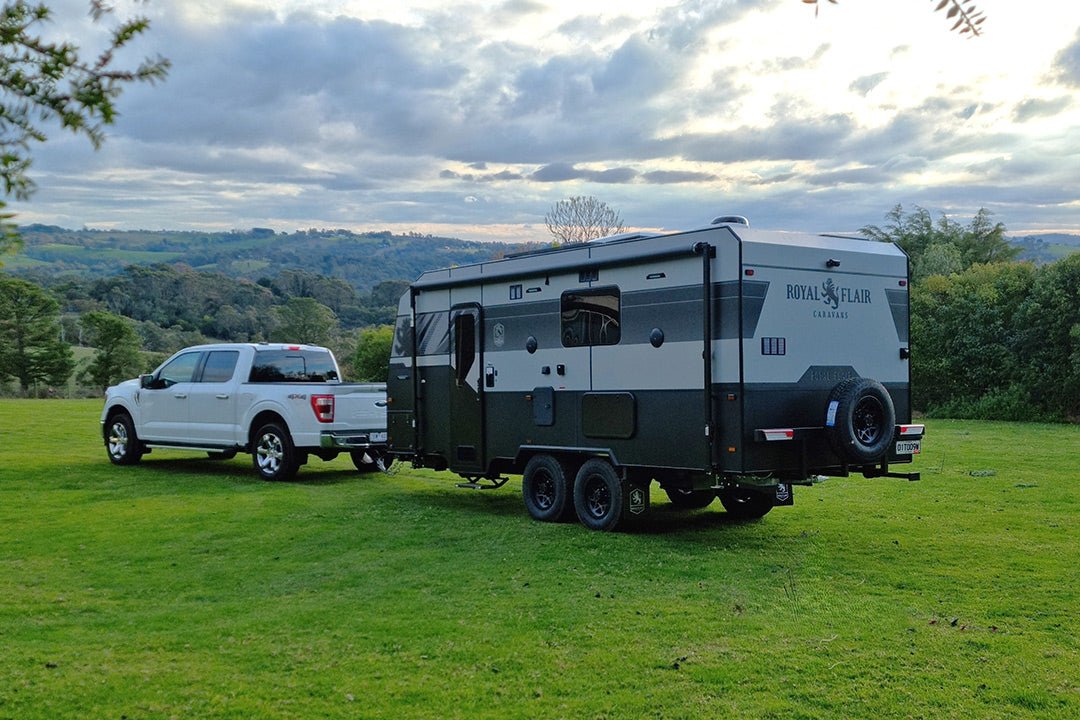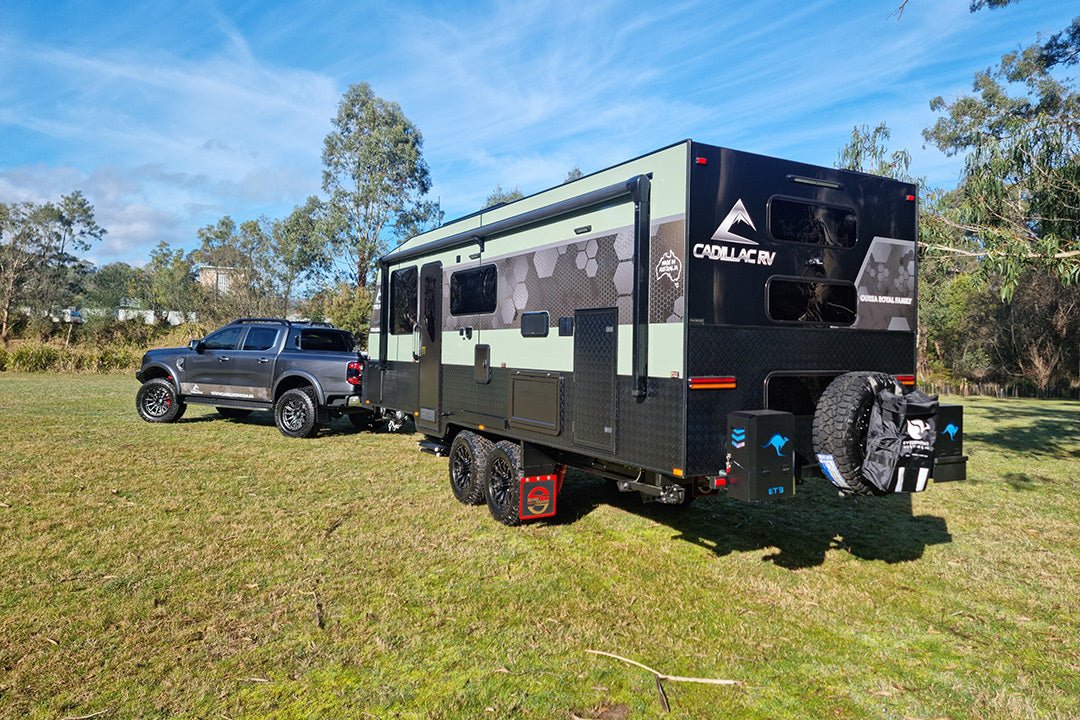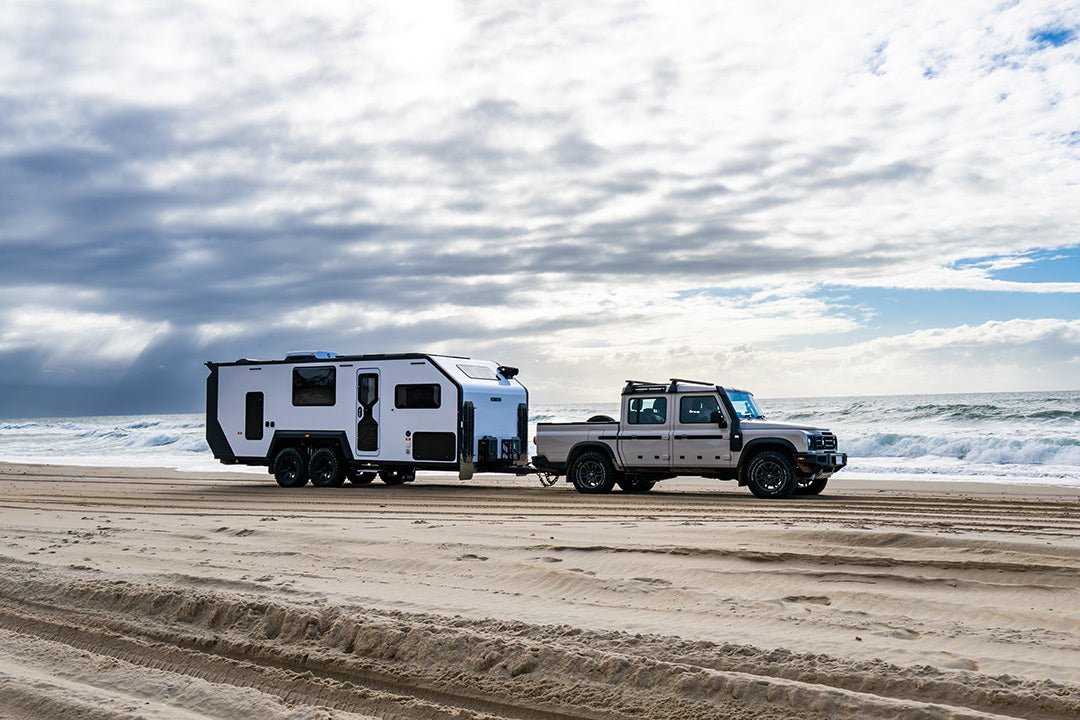Airbag suspension for 4WDs

There was a time when a caravan was a simple plywood structure with minimal features. They weighed very little and could easily be towed around by even the modest vehicles of the day. Then we, the buying public, began to ask for ensuites and big fridges and hot water services and air-conditioners and televisions and all the other impedimenta of life that fills our homes to bursting. Those homes on wheels grew accordingly.
These days, our caravans commonly start at around a tonne-and-a-half in weight – and frequently much more – even when empty, and our tow vehicles have to be large 4WDs or similar. Aside from the fuel consumption and aerodynamic loads they impose on our vehicles, it’s the sheer weight, even when they are standing still, that makes them a major burden on those vehicles.
One of the more obvious loads imposed becomes apparent as we lower the hitch on to the towbar. The coupling makes contact as we lower the drawbar with the jockey wheel, causing the back of the vehicle to sag a little. We keep winding the jockey wheel up, but it stays firmly on the ground, causing the back of the car to lower instead.
If this is the case for you, maybe you should read on, because you could have some problems to consider. All that weight on the back of the tow vehicle has overburdened the rear suspension and caused it to sag. Pushing down on the rear end not only lowers that part of the vehicle, it causes the nose to rise, lessening the weight on the front end. As this is where the steering takes place and most of the vehicle’s braking is done, this is not a desirable outcome.
Reduced front wheel contact will amplify any sway induced by the towed mass, increasing the chance of a jack-knife situation on the highway. At night, your headlights will be illuminating tree tops, and you’ll be the most hated driver by everyone coming the other way.
And if your vehicle has an independent rear end, like my Mitsubishi Pajero, then you’re going to notice a change in the camber of the rear wheels. That independent rear end helps give the Paj great ride and handling characteristics on the highway, but now all that weight is causing the suspension arms to rotate upwards and forcing the wheels to roll on the inner edges of the tyres. This is called negative camber and will be scrubbing the life out of those tyres.
BAG LIMIT
So what, if any, is the solution? One relatively easy answer is rear suspension airbags. There are a number of brands on the market but we went to see Polyair Springs, in the inner Sydney suburb of Sydenham, and with outlets right across Australia. Polyair has sold springs in Australia for 35 years and has been on the market in the US since 1949, so if it hasn’t got it right, nobody has.
Polyair produces a range of airbag solutions for assisting the rear suspensions of vehicles, whether they be coil or leaf springs. Its Red Series of airbags offers up to 450kg of load support and is the answer for the average owner of a caravan or camper.
The kits come with the bags (properly referred to as air springs), installation valves, airline, all fittings and mounting hardware and detailed installation instructions. If you are handy and used to working on and under your vehicle, they can be installed at home, but we figured these were too important and chose to have Polyair install them for us. With coil-sprung setups, the springs must be removed for installation so it becomes a bigger job than with leaf springs, although if there are bump stops, such as with a LandCruiser, then even that has to be removed.
Airbags are not designed to lift an already sagged, overloaded suspension. The idea is to pump up the pressure in the bags first, then apply the load to prevent it sagging. The airbags don’t work by pushing in a vertical plane, but rather apply their pressure outwards, in all directions, against the coils to limit movement.
Once installed and before using them for the first time, check the height from the rear wheel centre to the top of the guard above then pump the bags up to 35psi before hitching up your van or camper. Start reducing the pressure, a little at a time, until you start to see the suspension drop, measured by the distance between the rear wheel centre and the guard. That is the pressure you’ll need for your future towing of that van and that setup.
With an independent rear end, 35lb (15.9kg) is the maximum recommended pressure for the airbags. The optimal weight of a live rear axle will be 5-10lb (2.6-4.5kg) lower because of the more efficient design of the springs, which are mounted further out from the diff centre, and because of the bigger springs. However, the counter is that such setups can take a higher maximum pressure (up to 45psi) and, therefore, assist with greater weight.
On a long trip, monitor the airbag pressures at the end of each day as part of your post-drive checks. Heat from use can raise the bag pressure, so you may need to lower the pressure for the beginning of the day’s drive to allow for this and prevent over-inflation, especially over corrugations during high ambient temperatures.
During those times when you’re not towing, you should keep a minimum of 5-10lb (2.6-4.5kg) of pressure in the bags. At this level, you will not notice them there and your vehicle will still be comfortable to drive on the road and, as such, the bags will be reducing body roll, which is always an issue with 4WDs.
If you have one of those 4WDs with a lot of add-ons, such as a roof tray, spare wheel carrier, tow bar, rear drawers or second fridge, then maybe a minimum setting of 10lb (4.5kg) would be more suitable.
When you’re changing a tyre or removing a wheel, ensure the bags stay in the coil springs. This ought to happen if you’re driving offroad as the dust tends to hold the bag in a reasonable shape within the coil. If you’ve been driving around town you can help things out by putting 20psi pressure in the bags to hold them in place.
Keep in mind that airbags are not designed to replace a good suspension. They are intended to compensate for ball loads of 150-200kg, not for all those huge extra loads of familiar offroad extras plus a 3t van on top of that. If that’s your situation, talk to someone about your entire suspension package.
HOW LONG WILL AIRBAGS LAST?
Polyair claims to know of a pair of airbags that have been on the road for 19 years and have covered close to 800,000km, so it’s possible they could outlast your car. All Polyair kits come with a two-year unlimited warranty, and if you ever split a bag along the seam, no matter how old it is, Polyair will replace it.
THE COST?
We spent $345 on the basic kit, $220 to have them fitted at Polyair’s depot and $132 for the recommended wheel alignment. Some installations will be cheaper, as there is no wheel alignment required for live axle installs, and some vehicles have slightly cheaper kits.
HOW DID IT WORK?
When we had our Pajero fitted up, we were going simply on recommendation, so were keen to see just what we had acquired and how well it would work.
When empty, the Pajero had a distance of 500mm from the wheel centre to the guard above on the left and 495mm on the right, indicating a slightly sagged suspension on that side, even after only three years of use.
With the Polyairs installed and inflated to 35psi the ride height had increased to 511mm and 508mm respectively.
Without the Polyair assistance, our Vista Crossover XL, which has a Tare ball weight of 130kg, pushed the rear end down to 477mm and 475mm on the left and right, but at 35psi that went up to 490mm and 486mm. By careful adjustment, we were able to drop that to 26psi before the rear started to sag again. In practice, I’d probably run it at around 30psi, as I would normally also be carrying camping gear in the back of the vehicle that would add to the rear suspension load.
Those figures may not seem much, but when they were accompanied by an equivalent lowering of the front end, the attitude of the vehicle changed and handling and braking improved.
Overall, it was an exercise that was well worth the money.
The full test appears in Caravan World #554 August 2016. Subscribe today for the latest caravan reviews and news every month!







